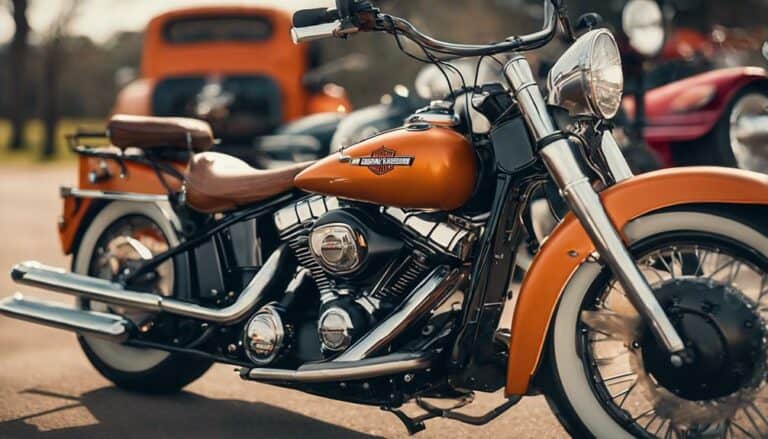When you think of Harley-Davidson, the image of their powerful motorcycles likely comes to mind first.
However, did you know that Harley-Davidson also explored creating other unique vehicles beyond two-wheelers?
Some of these ventures may surprise you and shed light on the brand's diverse engineering endeavors.
Stay tuned to uncover the lesser-known side of Harley-Davidson's vehicle history and the intriguing projects they undertook.
Key Takeaways
- Harley-Davidson diversified with motorcycles like Hummer and Aermacchi.
- Buell motorcycles innovated with unique designs and performance features.
- Harley-Davidson briefly acquired and sold MV Agusta Group for expansion.
- Custom Vehicle Operations offer exclusive, high-end motorcycles with unique features.
Harley-Davidson's Hummer, Sportcycle, and Aermacchi
Harley-Davidson's Hummer, Sportcycle, and Aermacchi motorcycles revolutionized the market by offering diverse options tailored to varying rider preferences and needs. The Hummer, produced from 1955 to 1959, catered to entry-level riders seeking adventure with its off-road capabilities.
On the other hand, the Sportcycle, unveiled in 1960, presented a compact and lightweight solution for urban commuting, powered by a 50cc engine perfect for navigating city streets with ease. The collaboration with Aermacchi in the 1960s resulted in the production of small-displacement bikes like the Sprint series, addressing the demand for nimble motorcycles.
Models such as the Sprint and Baja showcased Harley-Davidson's commitment to versatility, appealing to riders with different inclinations towards riding styles. By diversifying their offerings beyond heavyweight cruisers, Harley-Davidson demonstrated innovation in meeting the evolving needs of motorcyclists, solidifying their position as a brand that understands and caters to a wide range of riders.
Harley-Davidson's Buell Motorcycle Company
What innovations did the Buell Motorcycle Company introduce in the sport motorcycle market when Harley-Davidson acquired it in 1993?
The acquisition brought a fresh perspective to sport motorcycles by combining Harley-Davidson engines with Buell's innovative designs. Buell motorcycles stood out with features like the underslung exhaust, which enhanced performance and gave them a unique style. Another groundbreaking design was the integration of the fuel tank into the frame, improving weight distribution and handling.
Despite their innovative approach and growing popularity among enthusiasts for their performance, Harley-Davidson made the tough decision to discontinue the Buell brand in 2009 due to financial challenges.
The legacy of Buell lives on through the admiration of fans who still appreciate the brand's distinctive style and the way it pushed boundaries in the sport motorcycle segment. The Buell Motorcycle Company may be a thing of the past, but its impact on the industry and the hearts of enthusiasts remains strong.
Harley-Davidson's MV Agusta Group
Acquiring the MV Agusta Group in 2008, Harley-Davidson aimed to expand its presence in the premium motorcycle market by adding renowned brands like MV Agusta and Cagiva to its portfolio. This strategic move was part of Harley-Davidson's initiative to strengthen its position in the high-end motorcycle segment.
However, in 2010, Harley-Davidson decided to sell the MV Agusta Group to refocus on its core brand and streamline operations. The sale of the Italian motorcycle manufacturer allowed Harley-Davidson to concentrate on its primary business of manufacturing motorcycles, aligning with the company's core competencies.
Harley-Davidson's Custom Vehicle Operations
Renowned for their limited-edition, high-end motorcycles with unique features and premium finishes, the Custom Vehicle Operations division at Harley-Davidson exemplifies the pinnacle of craftsmanship and design innovation. These handcrafted CVO models boast special paint schemes, exclusive accessories, and powerful engines, providing riders with a personalized and luxurious experience on the road. Each CVO motorcycle is a testament to Harley-Davidson's commitment to excellence, showcasing not only top-tier quality but also unparalleled attention to detail.
The CVO lineup includes coveted models such as the CVO Street Glide, CVO Road Glide, CVO Limited, and CVO Tri Glide, offering riders a diverse range of custom options to choose from. These limited-edition motorcycles are highly sought after by collectors and enthusiasts alike for their exclusivity and exceptional performance. With the combination of premium finishes, exclusive features, and powerful engines, Harley-Davidson's Custom Vehicle Operations division sets the standard for high-end, personalized riding experiences.
Harley-Davidson's Cars and Other Vehicles
Harley-Davidson has a rich history of exploring diverse vehicle projects beyond motorcycles, including early car models and unique creations utilizing their equipment. The company produced three car models between 1903 and 1907 before transitioning focus to motorcycles.
Experimental projects like the Forecar and the Utilicar, released in 1966, showcased Harley-Davidson's foray into car-like designs. Homemade vehicles using Harley-Davidson equipment, such as the 1989 KennyBilt Harley-Davidson 9-Wheeler modified for living space, demonstrate the versatility of their products.
Custom cars resembling a blend of a truck and motorcycle have been crafted with Harley running gear and accessories, showcasing the brand's adaptability. Despite the primary focus on motorcycles, Harley-Davidson's exploration of car-like projects and involvement in unique vehicle creations highlight their innovative spirit in pushing the boundaries of transportation.
Conclusion
As you delve into the diverse world of Harley-Davidson's vehicle creations, you'll uncover a tapestry of innovation and ingenuity woven into each model. Like a symphony of chrome and steel, their Hummer, Sportcycle, and Aermacchi models sing a song of resilience and craftsmanship.
From the roar of their engines to the sleek lines of their designs, Harley-Davidson's legacy extends beyond motorcycles, leaving a lasting imprint on the automotive world.

